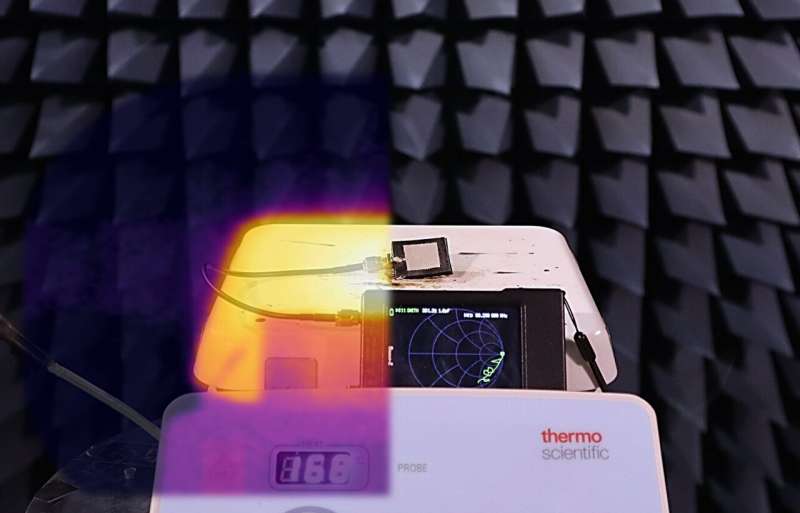This article has been reviewed according to Science X's editorial process and policies. Editors have highlighted the following attributes while ensuring the content's credibility:
fact-checked
peer-reviewed publication
trusted source
proofread
Researchers turn up the heat on flexible temperature sensor development using microwaves

Engineers from UK universities have developed a new method of measuring temperature through the interaction of a soft and flexible "smart skin" sensor with electromagnetic waves.
The sensor developed by the team is made from a composite of carbon fibers and silicon rubber, and works without battery power or onboard processing. The team's paper, titled "Wide-range soft anisotropic thermistor with a direct wireless radio frequency interface," is published in Nature Communications.
The flexible sensor's ability to absorb and reflect radio-frequency (RF) signals varies with atmospheric heat or cold, enabling the sensing of temperature across a much greater range than other comparable devices. It can also withstand thousands of cycles of bending and stretching without losing its sensitivity to temperature.
Temperature sensors are found in almost all electronic devices, and the global market for the technology is currently valued at $5–8bn.
Typical temperature sensors, known as thermistors, work by changing resistance in response to changes in temperature. However, they are usually only capable of measuring over narrow ranges of temperature variation, meaning temperature sensors often rely on an array of different thermistors to cover a wide sensing range.
The new soft, flexible temperature sensor, developed by a team led by researchers from the University of Glasgow, is capable of reading temperatures across a record-breaking range from 30°C to more than 200°C.
This could help make future wireless sensors cheaper and more sustainable, as fewer devices will now be required to cover the same temperature sensing range.
In the paper, the researchers show how used a 3D printer to mold the flexible material and integrated it into components like antennas, RFID labels, and resonators. Then they tested its ability to absorb radio-frequency (RF) radiation at different temperatures ranging up to 300°C.
Dr. Mahmoud Wagih, UK IC Research Fellow and Lecturer at the University of Glasgow, led the study. He said, "Sensors are the main interface between the analog world and smart devices. To communicate real-world changes in measurements like temperature or humidity to wireless smart devices, those measurements first need to be digitized.
"We designed a simple soft composite using common silicone and carbon fibers, which can be easily molded into any shape. These skin-like substrates could be used to design antennas over large areas, which can then radiate signals that are highly sensitive to temperature changes.
"Many researchers have used RF and microwave devices to measure liquid formulations, temperature, humidity, and other physical and chemical parameters. However, this level of sensitivity has not been demonstrated before."
Researchers from the University of Southampton supported the development of the flexible, stretchable sensor material, which could be easily integrated into bendable electronics and smart fabrics. The paper shows how the material could be bent and stretched for thousands of cycles, without significant changes in its response.
Collaborators from Loughborough University worked to characterize the new material's electrical properties, demonstrating how it functioned up to a frequency of 26 GHz, into the spectrum of 5G communications technologies. The team suggests that with "anisotropic" properties that change how the material interacts with electric fields in different directions, the composite could be further tailored to enhance or reduce sensitivity to specific wireless signals.
The technology could underpin a wide range of additional future applications including vital sign monitoring, radar sensing, satellite communications, and 6G wireless networks.
Dr. Wagih is now leading a new research project that will build on the research to find new applications in sustainable and biodegradable wireless electronics.
Dr. Wagih said, "We are delighted to start further research on functional and natively stretchable materials for body-centric wireless sensing, building on our track record in cutting-edge RF sensing.
"The UK is already a leader in applied microwave engineering and advanced materials, and we hope that collaborative research like this will help lead to results which can find commercial applications."
More information: Mahmoud Wagih et al, Wide-range soft anisotropic thermistor with a direct wireless radio frequency interface, Nature Communications (2024). DOI: 10.1038/s41467-024-44735-z




















